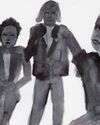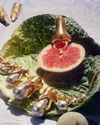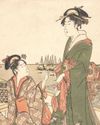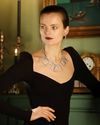
THE EXTRAVAGANT LUDWIG II, the so-called mad king of Bavaria, was said to love nothing more than a room aglow with painted glass. Indeed, his obsession with the art form galvanised the revival of stained-glass making in Germany, initiated by his grandfather Ludwig I in the early 19th century. During that era, elaborately designed windows — in churches but also secular buildings — became fashionable, with many
German artists and artisans adopting the craft, including Joseph Gabriel Mayer, who in 1847 founded Munich’s Mayer Institute of Christian Art, a workshop that produced religious sculptures and altars. By the 1880s, Mayer, who had by then been joined by his son Franz Borgias, had offices in Paris, London and New York City. (The company still has an office on Manhattan’s Madison Square Park.)
Over the years, Mayer created the windows for Ludwig II’s Neuschwanstein castle chapel in Bavaria, as well as the Königshaus am Schachen, his legendary folly of a hunting lodge near Garmisch-Partenkirchen. In 1892, Pope Leo XIII awarded the company the church’s prestigious Pontifical Institute of Christian Art title and, soon after, one of the most important commissions of that era, now perhaps the most recognised stained-glass window in the world: the Holy Spirit window above the main altar of St. Peter’s Basilica in Vatican City, an abstract design of deep orange and yellow splinter shaped glass surrounding a dove. Mayer’s work, distinguished by its saturated colours, painterly but naturalistic images and allusions to late Gothic artists like Hans Holbein the Elder, came to define the era’s Catholic churches.
This story is from the January 2021 edition of T Singapore: The New York Times Style Magazine.
Start your 7-day Magzter GOLD free trial to access thousands of curated premium stories, and 9,000+ magazines and newspapers.
Already a subscriber ? Sign In
This story is from the January 2021 edition of T Singapore: The New York Times Style Magazine.
Start your 7-day Magzter GOLD free trial to access thousands of curated premium stories, and 9,000+ magazines and newspapers.
Already a subscriber? Sign In

Look At Us
As public memorials face a public reckoning, there’s still too little thought paid to how women are represented — as bodies and as selves.

Two New Jewellery Collections Find Their Inspiration In The Human Anatomy
Two new jewellery collections find their inspiration in the human anatomy.

She For She
We speak to three women in Singapore who are trying to improve the lives of women — and all other gender identities — through their work.
Over The Rainbow
How the bright colours and lively prints created by illustrator Donald Robertson brought the latest Weekend Max Mara Flutterflies capsule collection to life.

What Is Love?
The artist Hank Willis Thomas discusses his partnership with the Japanese fashion label Sacai and the idea of fashion in the context of the art world.

The Luxury Hotel For New Mums
Singapore’s first luxury confinement facility, Kai Suites, aims to provide much more than plush beds and 24-hour infant care: It wants to help mothers with their mental and emotional wellbeing as well.

Who Gets To Eat?
As recent food movements have focused on buying local or organic, a deeper and different conversation is happening among America’s food activists: one that demands not just better meals for everyone but a dismantling of the structures that have failed to nourish us all along.

Reimagining The Future Of Fashion
What do women want from their clothes and accessories, and does luxury still have a place in this post-pandemic era? The iconic designer Alber Elbaz thinks he has the answers with his new label, AZ Factory.

A Holiday At Home
Once seen as the less exciting alternative to an exotic destination holiday, the staycation takes on new importance.
All Dressed Up, Nowhere To Go
Chinese supermodel He Sui talks about the unseen pressures of being an international star, being a trailblazer for East Asian models in the fashion world, and why, at the end of the day, she is content with being known as just a regular girl from Wenzhou.